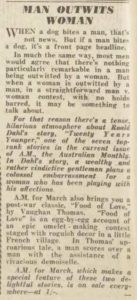Sections: Information | Plot Description
Information
- First published:
- October 1952 issue of Man’s Magazine
- Originally published under the title “An African Story”
- Magazine publications:
Plot Description
“An African Story” was first published in Over to You: Ten Stories of Flyers and Flying, but it actually has very little to do with that aeronautical theme. The story comes to us in the form of a found manuscript, which the narrator (Dahl) supposedly found in the suitcase of a fellow RAF pilot and friend who died in combat. The manuscript is the dead pilot’s recollection of a story that was told to him by a strange old African man following a forced landing in the Nairobi Highlands. In other words, “An African Story” is about a story about a story.
Spoiler warning! In the found manuscript’s story, the old African man lives in his small shack with his dog, some chickens, a cow, and another man named Judson (evidently some sort of helper). Judson is an irritable fellow, and the sound of the dog licking its paw practically drives him mad. He strikes it with a bamboo rod and breaks its back. The old man puts the dog out of its misery and curses at Judson. Later they begin to have a mysterious problem with the cow: her milk is disappearing during the night. The old man waits up one night and sees something amazing – a deadly poisonous black mamba snake is visiting the cow and drinking milk from her udders! After making sure that this goes on every night, he tells Judson that a small boy is stealing the milk and that Judson should hide beside the cow and catch him in the act. Judson does this and is of course bitten by the snake. He dies there in the meadow, and as the old man watches the snake again begin to suckle at the cow, he says quietly, “You can have his share… Yes, we don’t mind your having his share.”

